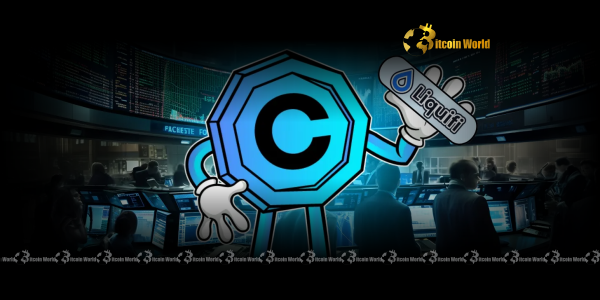BitcoinWorld

Massive 250 Million USDC Minted: What It Means for Crypto
The cryptocurrency world is constantly buzzing with activity, and few events capture attention quite like large movements of stablecoins. Recently, the crypto community was alerted to a significant development: a massive 250 million USDC minted at the USDC Treasury. This isn’t just a number; it’s a signal that can provide valuable insights into the current state and potential future direction of the digital asset landscape. But what exactly does this mean, and why should you pay attention to such a large stablecoin injection? Let’s unpack this crucial event and explore its wider implications for the market.
Understanding the 250 Million USDC Minted Event
When we hear about a large sum of USDC minted, it’s natural to wonder about the mechanics behind it. USDC, or USD Coin, is a stablecoin pegged 1:1 to the US dollar, co-founded by Circle and Coinbase. Unlike volatile cryptocurrencies such as Bitcoin or Ethereum, USDC aims to maintain a stable value, making it a crucial bridge between traditional finance and the decentralized world.
So, what does it mean for 250 million USDC to be “minted”?
- Creation of New Supply: Minting refers to the process of creating new tokens. In the case of USDC, this happens when an authorized entity (like Circle) receives fiat currency (USD) from an institutional client or partner. For every dollar received, one USDC is created and put into circulation.
- Responding to Demand: Large mints, such as this 250 million injection, typically indicate a significant demand for USDC. This demand can come from various sources: institutional investors looking to enter the crypto market, traders seeking liquidity, or decentralized finance (DeFi) protocols requiring stable collateral.
- Treasury Role: The “USDC Treasury” isn’t a physical vault but rather a digital address or smart contract where newly minted tokens are initially held before being distributed. It’s a transparent ledger entry, verifiable on the blockchain, showing the creation of these new units.
This particular event, reported by Whale Alert, highlights a substantial influx of new capital or a repositioning of existing capital within the crypto ecosystem. It signifies that someone, or a group of entities, has deposited a quarter of a billion US dollars with Circle, expecting an equivalent amount of USDC in return. This action suggests a strong intent to engage with the digital asset space, whether for trading, yield farming, or other investment strategies.
Decoding Stablecoin Supply Dynamics and Crypto Market Trends
The increase in stablecoin supply is often viewed as a bullish indicator for the broader cryptocurrency market. Why? Because stablecoins like USDC act as a primary on-ramp for fiat currency into the crypto ecosystem. When more stablecoins are minted, it suggests that more traditional capital is entering the space, ready to be deployed into various digital assets.
Let’s consider the dynamics:
- Increased Liquidity: A larger supply of USDC means more liquidity available within exchanges and DeFi protocols. This increased liquidity can facilitate larger trades, reduce slippage, and make the market more robust.
- Potential for Buying Pressure: While USDC itself is stable, the reason for its minting is often to purchase other cryptocurrencies. Traders and investors use stablecoins to buy Bitcoin, Ethereum, or altcoins without directly using fiat on exchanges, especially in jurisdictions with strict banking regulations or for speedier transactions. This anticipation of buying pressure can positively influence crypto market trends.
- DeFi Growth: USDC is a cornerstone of the decentralized finance (DeFi) ecosystem. It’s used extensively for lending, borrowing, yield farming, and providing liquidity on decentralized exchanges. A significant increase in USDC supply can fuel further growth in DeFi, leading to higher total value locked (TVL) and more innovative financial products.
Historically, periods of significant stablecoin minting have often preceded upward movements in the crypto market. While correlation doesn’t always imply causation, the logic is sound: new capital entering the ecosystem via stablecoins is typically looking for opportunities to generate returns, and those returns often come from volatile assets.
Consider this simplified view:
| Stablecoin Action | Potential Market Impact | Reasoning |
|---|---|---|
| Large Minting (e.g., 250M USDC) | Increased Liquidity, Potential Buying Pressure | More fiat capital entering crypto, ready for deployment. |
| Large Burning (Redemption) | Reduced Liquidity, Potential Selling Pressure | Fiat capital exiting crypto, or moving to other stablecoins. |
| Stablecoin Held on Exchanges | “Dry Powder” for Future Buys | Funds waiting for opportune moments to invest. |
This 250 million USDC minting event suggests that a substantial amount of “dry powder” is now available, poised to potentially influence future market movements. It’s a signal that institutional or large-scale retail interest remains strong, indicating confidence in the long-term prospects of digital assets.
The Significance of Whale Alert Reports in Tracking Digital Currency
The information about the 250 million USDC mint came from Whale Alert, a popular and respected cryptocurrency transaction tracker. Why are reports from services like Whale Alert so important for understanding the flow of digital currency?
- Transparency and Visibility: Blockchain technology is inherently transparent. Whale Alert leverages this by monitoring and reporting large transactions across various cryptocurrencies. This provides real-time visibility into significant movements that might otherwise go unnoticed by the average investor.
- Market Sentiment Indicator: Large transactions, especially those involving stablecoins or significant amounts of Bitcoin and Ethereum, can be powerful indicators of market sentiment. A large stablecoin mint suggests accumulation or preparation for investment, while large transfers to exchanges might indicate selling pressure.
- Identifying “Whales”: The term “whale” refers to an individual or entity holding a substantial amount of cryptocurrency. Whale Alert helps track these movements, giving insights into the activities of major market players whose actions can significantly influence prices.
- Early Warning System: For astute traders and analysts, Whale Alert reports can act as an early warning system. For instance, a series of large stablecoin mints might suggest an impending rally, while large transfers of volatile assets to exchanges could signal a potential sell-off.
In this specific case, Whale Alert’s report of the 250 million USDC mint immediately brought this significant event to the attention of millions, sparking discussions and analysis across crypto news outlets and social media. It underscores the value of on-chain data in providing a clearer picture of market dynamics beyond just price charts.
What Does This Mean for the Broader Digital Currency Ecosystem?
The minting of 250 million USDC is not an isolated event; it has ripple effects across the entire digital currency ecosystem. Its implications extend beyond just market prices, touching on liquidity, innovation, and even regulatory landscapes.
Benefits of Increased Stablecoin Supply:
- Enhanced Trading Opportunities: More USDC means more pairs available for trading, and potentially tighter spreads on exchanges.
- Fueling DeFi Innovation: Developers and protocols can build more robust and complex financial instruments when there’s ample stablecoin liquidity. This can lead to new lending platforms, decentralized exchanges, and yield-generating opportunities.
- Institutional Adoption: Large mints often originate from institutional players. This signifies growing confidence from traditional finance in using stablecoins as a gateway into digital assets, paving the way for broader institutional adoption.
- Cross-Border Payments: USDC facilitates faster, cheaper, and more efficient cross-border transactions compared to traditional banking systems, contributing to global financial inclusivity.
Challenges and Considerations:
- Centralization Concerns: While USDC is transparent, it is centrally issued by Circle. This raises questions about censorship resistance and potential regulatory pressures on the issuer.
- Regulatory Scrutiny: The growth of stablecoins has attracted significant attention from regulators worldwide. Large movements like this mint could further highlight the need for clear regulatory frameworks, which can be both a benefit (for clarity) and a challenge (if overly restrictive).
- Market Volatility: While stablecoins are designed to be stable, the influx of capital they represent can contribute to volatility in other crypto assets if deployed rapidly.
This substantial USDC mint reinforces the stablecoin’s critical role as a liquidity backbone for the crypto industry. It signals continued growth and maturity of the digital asset space, attracting both retail and institutional participants looking to leverage the efficiency and innovation offered by blockchain technology.
Actionable Insights for the Savvy Investor
For those navigating the dynamic world of cryptocurrencies, understanding events like the 250 million USDC minted report offers valuable insights. Here are some actionable takeaways:
- Monitor Stablecoin Flows: Keep an eye on Whale Alert and similar trackers for significant stablecoin mints and burns. These can be leading indicators of market sentiment and potential price movements. A sustained increase in stablecoin supply often precedes market rallies.
- Assess Market Liquidity: Increased stablecoin supply typically translates to higher market liquidity. This can mean less slippage on trades and more efficient execution, especially for larger positions.
- Diversify Your Portfolio: While stablecoins are crucial for liquidity, they don’t offer capital appreciation. Consider how the influx of stablecoins might be deployed into other assets and adjust your portfolio strategy accordingly. This could involve looking at major cryptocurrencies or promising altcoins that might benefit from new capital.
- Stay Informed on DeFi Trends: Given USDC’s prominence in DeFi, an increased supply could indicate a boom in decentralized applications. Explore new yield farming opportunities, lending protocols, and DEXs that might benefit from enhanced liquidity.
By staying informed and understanding the underlying mechanics of these large transactions, investors can make more informed decisions and potentially capitalize on emerging trends within the crypto market.
Conclusion: A Clear Signal of Continued Growth
The recent report of 250 million USDC minted at the USDC Treasury is more than just a headline; it’s a powerful indicator of the sustained and growing interest in the digital asset space. This substantial increase in stablecoin supply signals enhanced liquidity, potential for significant buying pressure, and a vibrant future for the crypto market trends. As Whale Alert continues to highlight these large movements, it provides invaluable transparency into the actions of major players, offering crucial insights into the evolving landscape of digital currency.
Whether you’re a seasoned investor or new to the space, understanding these fundamental shifts in stablecoin dynamics is key to navigating the opportunities and challenges that lie ahead. This event underscores the increasing maturity and integration of stablecoins as a foundational element of the global financial system, bridging traditional finance with the innovative world of blockchain.
Frequently Asked Questions (FAQs)
Q1: What does “minting USDC” actually mean?
A1: Minting USDC means creating new USDC tokens. This occurs when an authorized entity, like Circle, receives an equivalent amount of fiat currency (USD) from a customer. For every US dollar received, one USDC is created and put into circulation, ensuring it remains pegged 1:1 to the dollar.
Q2: Why is a large USDC mint considered a bullish sign for the crypto market?
A2: A large USDC mint is often seen as bullish because it indicates that a significant amount of traditional capital (USD) is entering the crypto ecosystem. This new capital is typically used to buy other cryptocurrencies, increasing liquidity and potentially leading to upward price pressure on assets like Bitcoin and Ethereum.
Q3: How does Whale Alert track these transactions?
A3: Whale Alert monitors public blockchain ledgers. Since all cryptocurrency transactions are recorded on a public blockchain, Whale Alert uses sophisticated algorithms to identify and report unusually large transfers between wallets, exchanges, and treasuries in real-time.
Q4: Is USDC truly decentralized?
A4: USDC is a centralized stablecoin, meaning it is issued and managed by a specific entity (Circle and Coinbase). While it operates on decentralized blockchains, its issuance and redemption processes are controlled by a central authority, distinguishing it from decentralized stablecoins like DAI.
Q5: What are the risks associated with a large stablecoin supply?
A5: While a large stablecoin supply generally indicates liquidity, potential risks include increased regulatory scrutiny on issuers, concerns about the transparency and auditability of reserves, and the potential for market volatility if a large portion of the stablecoin supply is suddenly converted into volatile assets or redeemed for fiat.
Q6: How can I monitor stablecoin movements myself?
A6: You can monitor stablecoin movements by following blockchain explorers for networks like Ethereum (where USDC primarily operates), subscribing to services like Whale Alert, or using crypto market data platforms that track stablecoin market capitalization and on-chain flows.
Did you find this article insightful? Share your thoughts and help spread the knowledge about the fascinating world of cryptocurrency. Your shares on social media help us reach more people interested in understanding these crucial market dynamics!
To learn more about the latest crypto market trends, explore our article on key developments shaping digital currency institutional adoption.
This post Massive 250 Million USDC Minted: What It Means for Crypto first appeared on BitcoinWorld and is written by Editorial Team





